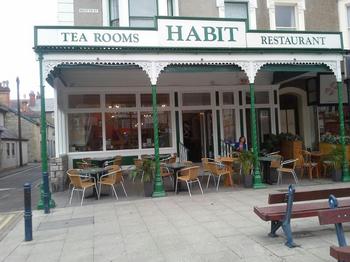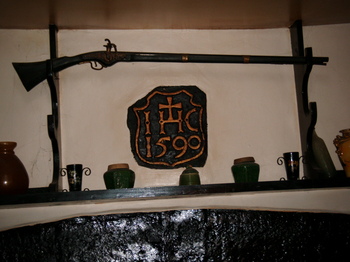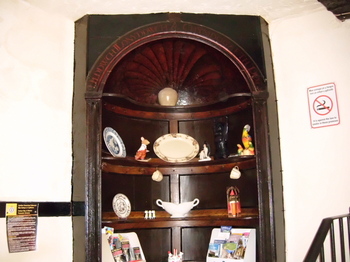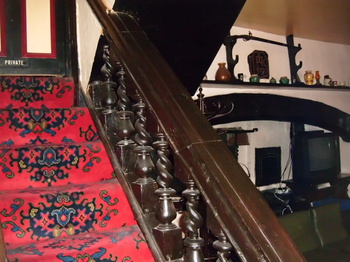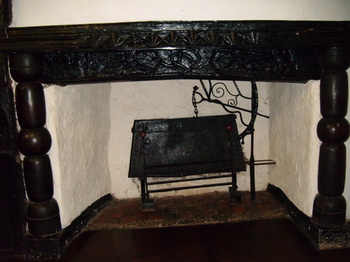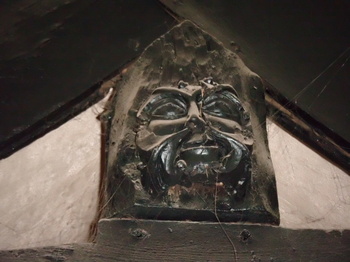The History of Penrhyn Old Hall
Interesting Facts Regarding the Hall's History
The origin of Penrhyn Old Hall is somewhat enveloped in mystery. According to Roderick Moelwynog, Prince of Wales, grandson of Cadwalder, the last King of the Britons, built a Palace on this spot early in the eighth century. The family of Penrhyn are mentioned in records in Edward 111’s reign of 1327 – 1377.
Penrhyn was described as an ancient stone house by Leyland in 1549, (John Leyland was appointed King’s Antiquary by Henry V111, and he included this district in his itinerary).
In early times there was an ancient trackway past this spot, and it is more than likely that the Romans made use of it during their occupation of Wales in order to reach the copper mines on the Great Orme. This is confirmed by the discovery in 1873 and in 1907 of a large number of Roman coins dated from the time of Constantine and of Carausius.
Saxon, who mapped this area of Creuddyn in 1575 marked the four churches of the district, Eglwys Rhos, Llangwstennin, Llandrillo and St Tudno (Llandudno) but only one manor is shown, namely Penrhyn. This shows that it was a place of some importance in the days of Elizabeth 1 as both Gloddaeth Hall and Bodysgallen Hall would also have been in existence at this time.
Today, Plas Penrhyn, now known as Penrhyn Old Hall is included in the suburbs of Llandudno but in Elizabethan times it stood in a lonely rural district and housed a powerful Roman Catholic family named Pugh (their coat of arms appears over the front doorway) and Robert Pugh of Penrhyn was High Sheriff of Caernarvonshire in 1561. They kept a priest who officiated in the domestic chapel in the grounds of the house, which is now derelict. The chapel is believed to be that of the original St Mary's which was built in 1447. The chapel was also used for the boiling of pig food. It is known that in 1900 it was used as a stable. The chapel was restored in 1926 and used until 1930 when the church in St David's Road was built. There is a story published in1835, that in the late 16th century some Roman Catholics formed a conspiracy to put to death all the Protestants in Creuddyn. It was arranged for a body of men to arrive on a certain night at a spot indicated, A man employed at Gloddaeth Hall was informed by a girl in service at Penrhyn of what was going on and gave the alarm.
A messenger was sent at once from Gloddaeth for assistance and a Troop of Horse arrived and Penrhyn was surrounded. Some of the alleged conspirators escaped whilst others were taken. The priests who were supposedly involved escaped for nearly a year. One of them was William Davis. Their time of hiding was spent writing and operating a printing press in a cave on the Little Orme. This is where the first book printed in Wales was made.
They were subsequently arrested in Holyhead trying to board a boat to Ireland. William Davis was hanged, drawn and quartered in Beaumaris in 1593. It is believed that the Pugh’s acquired his hand and concealed it in a hole behind the house. After the departure of the Pugh’s, among other things left behind was an old trunk. When this was opened a withered hand was found inside, supposedly belonging to the priest William Davis. There is a stone dated 1590 above the large fireplace in the Tudor Bar commemorating his stay here. The fireplace also hides a priest hole. William Davis was beatified by the pope in 1990.
There was a tale from the 1720’s which may or not be wholly true. One of the Pugh’s was an only son with two sisters. He travelled abroad for many years until he was presumed that he had perished. Much later he returned home as a beggar only to find his sisters did not believe he was their long lost brother, probably because they had gained their parents’ inheritance. To prove his identity he stated that as a youth he had placed a needle between one of the joists and the ceiling of the kitchen. This was found. He then proceeded to the pear tree in the garden where some bark was removed to reveal a nail which he said he had also placed there. With this he was seized , flogged with a whip which had large pins fixed to it and then ejected from the premises. A neighbour who had recognised him for who he was, took him into his home until one day he went out, never to return. Many years later a complete skeleton of a man was found in the lime kiln at the side of the house. It is possible this could have been the missing brother.
In 1760 Penrhyn Hall became the home of Dr. John Williams, Archbishop of York and Lord Keeper of the Great Seal to King James 1, and later to a family named Owen who found the first of the Roman coins in 1873.
It seems both from records and the style of architecture of certain parts of the Hall, that the greater portion of the present building, the wing of the stepped gable was completed in 1422. The front hall is, on the whole, the same as the building that stood at the end of the Elizabethan reign, though there may be differences in detail both inside and out. This old portion is shaped like the letter H, a central block containing the main entrance joining together two wings. The nearest portion of the central block is of uncertain date. The rest of the house was standing, for it had been built quite a few years before the Pugh family came to the Hall. Although there have been changes as the centuries have gone by, it may be truly called the same building as that in which William Davis was received as an honoured guest.
The entrance hall was partly cut out of solid rock which also forms the wall in places. In this room can be found a Madonna cupboard with the inscription “ Heddwch, Llonyddwch, a Chymdogaeth Dda”, which roughly translates as Peace, Tranquillity and Good Neighbourliness. The cupboard is dated 18th century.
The history of Penrhyn Old Hall from 1739 is a quiet and uneventful period, when Penrhyn became like many others of its kind in Wales – just an ordinary farmhouse.
From 1850 until his death in 1899 the house was occupied as a farm by Mr Dan Phillips. It is said that the great-great grandfather of the present Lord Mostyn was a great friend of the Phillips family. The house was later occupied by Mr Booth-Jones up to his untimely death on the Lusitania in May 1915. Mr Carrington-Sellers then bought Penrhyn Old Hall and made a lot of alterations especially to the windows, mainly enlarging them. He kept it as a private house. Since then the Hall has been an antique shop and museum, a hotel, during which time the tennis court at the rear was built, a private house and tearooms.
Please come back soon
The History of Penrhyn Old Hall Statistics: 0 click throughs, 909 views since start of 2025
